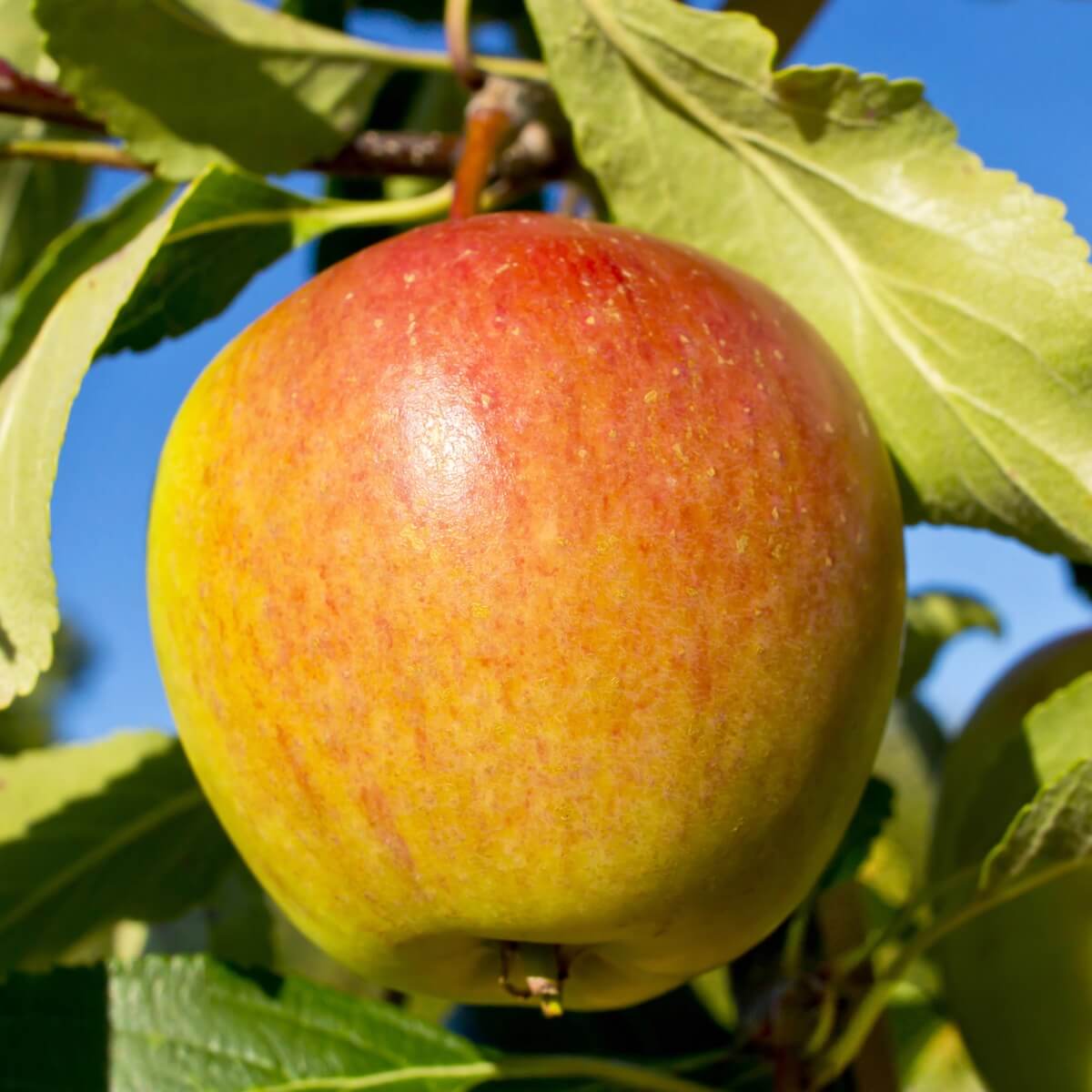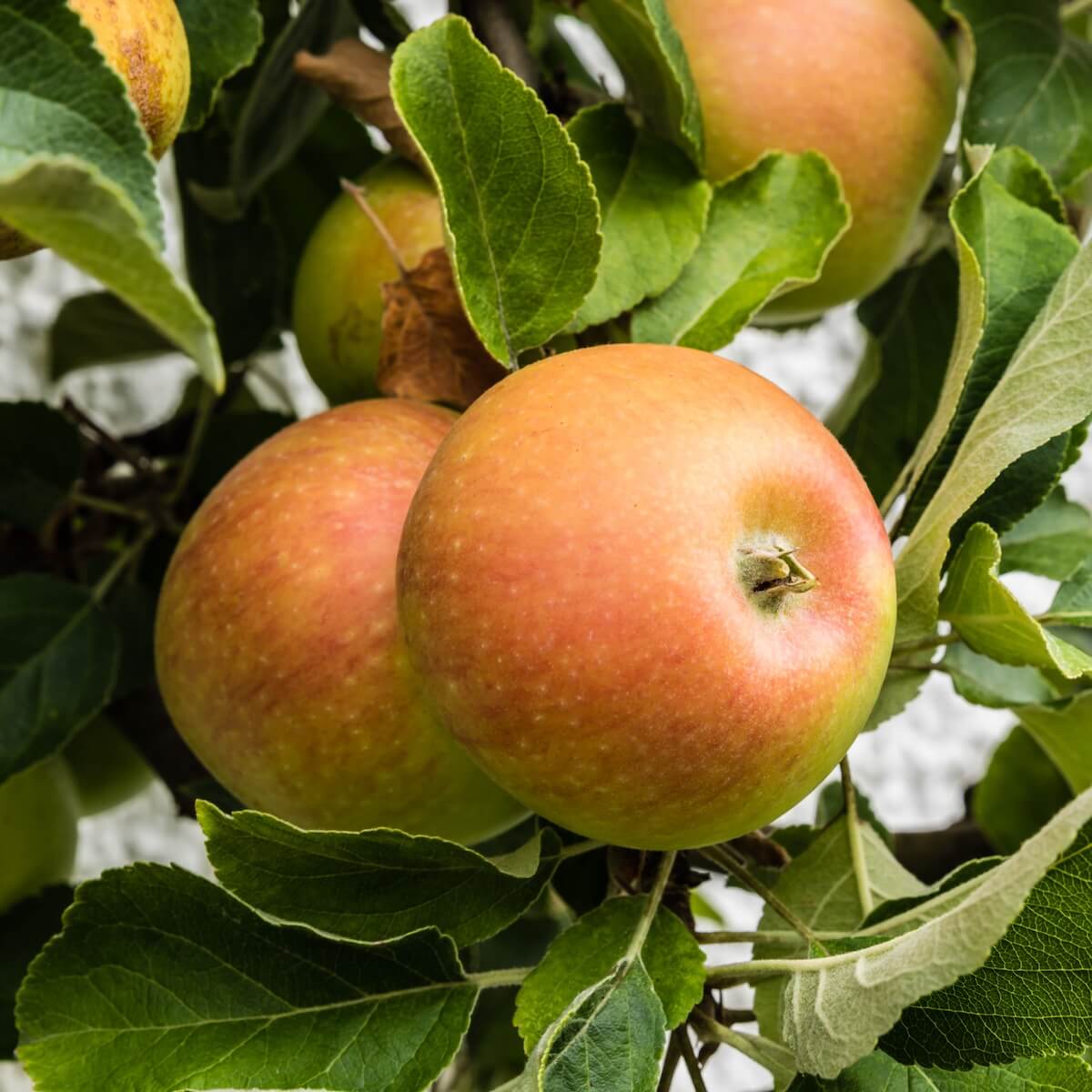
Position
- Full sun is essential
- South or west-facing aspect preferred
- Sheltered position away from strong winds
- Avoid frost pockets
Hardiness
- Hardy down to -20°C to -15°C (-4°F to 5°F)
- Needs cold winter periods for proper fruiting
- Protect blossoms from late spring frosts
Soil
- Deep, well-draining soil
- Moist but not waterlogged
- Rich in humus and nutrients
- Suits loamy or sandy soils
- Avoid heavy clay unless improved
- Neutral to slightly alkaline soil
- Optimal pH range 6.5-7.5
- Grab a soil test kit and ensure the perfect conditions for growth
Height
- 4-8 metres (13-26 feet)
- Size can be controlled through rootstock choice and training method
Seasons of Interest
- April-May: Beautiful pink and white blossoms
- June-August: Dense green foliage
- September-October: Orange-red striped fruit develops
- October-January: Fruit harvesting period
- Autumn: Modest yellow leaf colour before leaf fall
Additional Notes
- Partially self-fertile but crops better with a pollination partner
- Best pollinators include ‘James Grieve’, ‘Golden Delicious’, and ‘White Winter Calville’
- Needs annual pruning in winter and summer to maintain shape
- Regular fruit thinning is required in June for better-quality apples
- Keep a 60cm radius around the trunk clear of grass and weeds
- Susceptible to canker, scab, and mildew – requires good air circulation
- Apply a balanced fertiliser in early spring
- Regular watering is needed during dry spells
- Best grown on MM106 or M26 rootstock for garden cultivation
- Fruit stores well until January in proper conditions
- Considered one of Britain’s finest dessert apples
- Benefits from mulching in spring with organic matter
- May take 3-4 years to start fruiting properly
- Crops can be irregular – proper management helps establish regular bearing
The Ultimate Apple Cox’s Orange Pippin Growing Guide
Apple Cox’s Orange Pippin is considered one of the best-tasting apples in the world. First grown in 1825 by Richard Cox in Kent, England, this aromatic-flavoured apple remains a favourite among enthusiasts and gardeners. With its perfect balance of sweetness and tartness, it is an excellent dessert apple that can be eaten fresh or used in cooking.
If you are looking for an apple tree that is easy to grow and produces juicy, orange-red fruit, this guide will provide everything you need. Whether you have an extensive fruit tree orchard or a small garden, a Cox’s Orange Pippin apple tree is a fantastic choice.
Why Grow Cox’s Orange Pippin?
Cox’s Orange Pippin is a classic British apple cultivar grown since 1825. Its aromatic flavour and firm yet juicy texture make it one of the most popular eating apples. This variety is known for its disease resistance, making it an excellent option for beginners and experienced gardeners.
Its mid-season fruit ripens in early October and can be stored for several months. Unlike some apple varieties, Cox’s apples develop a richer taste as they mature, making them even better after harvesting.
How to Grow a Cox’s Orange Pippin Apple Tree
What Are the Best Growing Conditions for Cox’s Orange Pippin?
The Cox’s Orange Pippin apple tree thrives in a sheltered sunny position with well-drained soil. It does best in a mild climate with cool summers, allowing the fruit to ripen slowly and develop its aromatic flavour.
Before planting, please ensure the soil is enriched with manure to provide essential nutrients. Adding organic matter will improve drainage if your garden has heavy clay soil.
What Type of Soil Does Cox’s Orange Pippin Need?
What Pollination Group does Cox’s Orange Pippin belong to?
Cox’s Orange Pippin belongs to pollination group 3, meaning it needs another variety to pollinate successfully. Good pollination partners include:
- Golden Delicious
- Red Delicious
- Braeburn
If space is limited, consider a self-fertile variety such as Cox’s Orange Pippin self-fertile, which won’t need another tree for fruit production. Please check out my article here for more information on Apple pollinating groups.
How Big Does a Cox’s Orange Pippin Tree Grow?
The ultimate tree size depends on the rootstock. Common options include:
- M9 rootstock (dwarf) – Grows to around 2.5m (8ft), ideal for small gardens.
- M26 rootstock (semi-dwarf) – Reaches 3-4m (10-13ft), an outstanding balance of size and yield.
- MM106 rootstock (vigorous) – Can grow up to 5m (16ft), perfect for larger gardens.
If growing in a pot, choose a dwarf rootstock for better control over growth.
How and When to Prune a Cox’s Orange Pippin Apple Tree?
Prune your Bramley apple tree during the winter when it is dormant to shape its structure, improve airflow, and remove any diseased or damaged branches. Regular pruning encourages strong growth, prevents overcrowding, and ensures the tree remains productive year after year. Maintaining an open canopy and removing excess growth can maximise sunlight exposure, reduce disease risk, and promote larger, healthier apple harvests.
What Are Common Issues for Cox’s Orange Pippin?
Cox’s Orange Pippin may be susceptible to scab and canker, affecting leaves and fruit. To prevent this:
- Ensure good airflow and avoid overwatering.
- Use disease-resistant rootstocks.
- Remove infected branches promptly.
Proper care will keep your tree productive and free from disease issues.

When Do Cox’s Orange Pippin Apples Ripen?
The first apples typically ripen in early October. Pick them when they are firm and have developed their orange-red colour. Store the apples in a cool, dry place for a few weeks before eating for the best flavour.
Can Cox’s Orange Pippin Be Grown in Containers?
Where Can I Buy Cox’s Orange Pippin Apple Trees?
You can buy Cox’s Orange Pippin trees from garden centres, nurseries, and online retailers. Look for a one-year-old tree grafted onto a suitable rootstock for your garden size.
From Darren’s Patch
I don’t grow Cox’s Orange Pippin myself, but I’m always happy to recommend it—especially if flavour is your top priority. It’s often described as the finest-tasting apple you can grow in the UK, and I’ve certainly never been disappointed when I’ve picked one fresh from a friend’s tree. That perfect mix of sweetness, acidity, and rich aroma is hard to beat. It does need a bit more attention than some other varieties, particularly regarding disease management, but for many, the reward is well worth the effort. Cox’s is a fantastic choice if you’ve got a sunny, sheltered spot and fancy something with a touch of history and a lot of character. Whether eaten fresh or baked into a pie, it captures the essence of traditional English apple growing.
![]()
Key Points to Remember:
- Cox’s Orange Pippin is one of the best-tasting apples in the world.
- It was first grown in 1825 in Kent, England, by Richard Cox.
- Requires well-drained soil and a sheltered sunny position for best results.
- Belongs to pollination group 3, needing a pollination partner unless self-fertile.
- Prune annually to maintain health and improve fruit quality.
- Ripens in early October, developing richer flavour over time.
- Can be grown in containers if using a dwarf rootstock.
- Available from garden centres and online retailers.
Growing a Cox’s Orange Pippin apple tree is a fantastic way to enjoy delicious, homegrown fruit while adding beauty to your garden. Whether you are a beginner or an experienced grower, this variety is a rewarding choice that will provide juicy apples for years to come!
To see the RHS article, please click here.
Want to learn about other apple varieties? Read about Apple Bramley’s Seedling here.
For more information on Fruit for your garden, please click here.
Frequently Asked Questions
Q: What is a Cox’s Orange Pippin apple?
A: Apple Cox’s Orange Pippin is a popular apple variety known for its sweet and slightly tart flavour. It is often considered one of the best-tasting apples and is a favourite among dessert apple lovers.
Q: Are Cox’s Orange Pippin trees self-fertile?
A: Yes! Cox’s Orange Pippin apples are self-fertile, meaning you can grow one tree in your garden and still get fruit. However, they do benefit from cross-pollination for increased yields.
Q: Where can I find Cox’s Orange Pippin trees for sale?
A: You can find Cox’s Orange Pippin trees for sale at local nurseries, garden centres, and online. Simply search for ‘pippin apple trees for sale’ to get started!
Q: What do Cox’s Orange Pippin apples taste like?
A: These apples have a delicious balance of sweetness and acidity, making them a flavourful choice. They are often described as having a fruity, aromatic profile perfect for eating fresh or baking.
Q: How do I care for a Cox’s Orange Pippin tree?
A: Caring for a Cox tree involves regular watering, pruning, and monitoring for pests. To keep your orange apple tree healthy, ensure it receives enough sunlight and is planted in well-draining soil.
Q: Can I plant a Cox’s Orange Pippin in a small garden?
A: Absolutely! These trees adapt well to smaller spaces. For the best results, ensure you provide enough room for growth and access to sunlight.
Q: When is the best time to harvest Cox’s Orange Pippin apples?
A: These apples are typically ready for harvest in late September to early October. Look for their distinctive orange-red colour to determine when they are ripe!
Q: How does the Cox’s Orange Pippin compare to other apple varieties?
A: The Cox’s Orange Pippin is often praised as one of the best-tasting apples, especially compared to other varieties like the Ribston Pippin. Its unique flavour makes it a standout in the apple world!
Q: Can Cox’s Orange Pippin apples be used for cooking?
A: Definitely! While they are excellent as a fresh snack, Cox’s Orange Pippins can also be used in cooking and baking, adding a rich flavour to pies and desserts.
Q: What is the history of the Cox’s Orange Pippin apple?
A: This cultivar was introduced for sale by the 1850s and quickly gained popularity, thanks partly to Charles Turner, who helped develop it. It has remained a favourite ever since for its exceptional taste and versatility!
